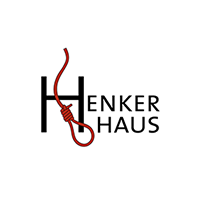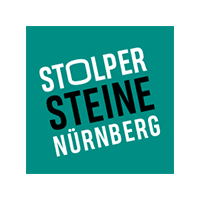Speech from Bernd Siegler at the laying of the stumbling stones on 30 April 2023
Who was Dr Leopold Neuburger, who we remember here, and who was his wife Hedwig and their children Hilde and Kurt, commemorated today by two stumbling stones in Nuremberg?
It was not on the football field that Jewish lawyer Dr Leopold Neuburger led the club, but at the forefront, as its chairman, at a time when it was necessary to put the club on the right track. He held this top position from 1912 until 1914 and from 1919 until 1921.
Neuburger was born on 14 October 1881 in Nuremberg, the son of Jewish businessman Salomon Neuburger and his wife Auguste (née Lerchenthal). He studied law, took up residence in Nuremberg as a lawyer and married Hedwig (née Berlin) on 3 November 1913.
In his first period in office as chairman of the Nuremberg Football Club he initiated the purchase and construction of the first large sports complex to belong to a club, the Zabo sports park. The club now had its own stadium. This was an important step for the club’s further development.
Neuburger chose the suburb of Zerzabelshof as the location for the sports complex because clubs there – unlike those within the city limits of Nuremberg – did not have to pay an “entertainment tax” (“Lustbarkeitssteuer”) on sporting events. So land was acquired in Zerzabelshof, to erect a modern sports park there.
On 23 August 1913, the Zabo park was presented to the public. A garden festival and a concert on that day was followed the day after by a match against Eintracht Braunschweig (3:5) and the official inauguration of the sports park. Due to the very impressive facilities, it was regarded as the “most beautiful sports park in Germany.”
Then came the First World War. After serving on the Western Front, Neuburger was sent to the Eastern Front in October 1915. There he was buried alive but survived and returned to Nuremberg after spending several months in a military hospital. In March 1919, he was again elected senior chairman and laid the foundations for the meteoric rise of the club in the “Golden 20s”.
When the club won the German league championship for the first time in 1920, after beating Fürth 2:0, it became a magnet for spectators. Neuburger managed the enlargement of the Zabo sports complex, increasing the spectator capacity of the main section to just under 25,000.
By this time, for work-related reasons, Neuburger was no longer chairman. His successor Karl Müller praised him as a “brilliant lawyer, who, as senior chairman, was always an outstanding speaker and administrator of the club’s interests.” Neuburger stayed with the club as chairman of the arbitration committee and administration board member.
Neuburger died on 25 July 1928, aged 46. The club’s newspaper of August 1928 reported that “Dr Neuburger’s services to Nuremberg Football Club, as loyal member, groundbreaking and purposeful leader and zealous colleague, are so intimately associated with the victorious rise of our club that they have created an immortal monument to him.”
Neuburger’s legacy can be found in the publication commemorating the club’s 25th anniversary – a clear affirmation of international understanding and anti-nationalism in sport. The first sentence of his article “Sport and Politics” says it all: “Our club, and the organisations it belongs to, are built on a foundation that is politically and religiously neutral.” For him it was a matter of “stating once again the principle of absolute political neutrality.”
For Neuburger – as was also the case with the Jewish editor of Kicker, Walther Bensemann – sport was a means to international understanding: “If one restricted sport to the borders of one’s country and if, through the strict implementation of this line of thought, one prohibited German sport from coming under foreign influence, then such incest would necessarily mean the ruination of this sport.”
He repudiated nationalistic ambitions: “The tighter the international bonds in sport, the greater the understanding and respect amongst individual nations for those that are different.” Sport bridges the “gap in understanding between one nation and another”.
Nuremberg Football Club pays tribute to Dr Leopold Neuburger. A stumbling stone cannot be laid in his memory because he died before the National Socialists came to power. For the artist Gunter Demnig, who started this project in 1992, stumbling stones are to commemorate those people who, in the National Socialist period – from 30 January 1933 onwards – were persecuted, murdered, deported, expelled from their homeland or driven to commit suicide.
However, stumbling stones are being laid today in memory of his widow Hedwig and their two children Hilde and Kurt.
Hedwig Neuburger played tennis at the club. In the membership card file, she is entered as “Mrs Neuburger”. She paid her membership fee regularly, on a quarterly basis. In her case, the card was not stamped “30 April 1933” – probably out of respect, because her husband was a former chairman of the club.
Hedwig Neuburger was born on 17 May 1892 in Nuremberg. Her parents were the Jewish businessman Ernst Berlin and his wife Rosa (née Hanau). Hedwig had three brothers: Friedrich-Wilhelm, Hans-Ludwig, who died in battle on the Eastern Front in 1914, and Robert, who died on 21 May 1909, aged 10.
On 3 November 1913, Hedwig Berlin married the lawyer Dr Leopold Neuburger in Nuremberg. The couple lived at Prinzregentenufer 3 and had two children: Kurt (born on 1 November 1914 in Nuremberg) und Hilde (born on 14 November 1919 in Nuremberg).
Kurt attended the Königliche Alte Gymnasium (Grammar School) in Nuremberg, today’s Melanchthon Gymnasium. On 1 October 1924, he also became a member of the Nuremberg Football Club, in the track and field athletics division. When the Jewish members were expelled on 30 April 1933, he was apparently overlooked. The club’s membership administration corrected this on 31 December 1933, stamping the date in the “resignation” (“Austritt”) section.
Hedwig Neuburger’s father died on 25 November 1921. Her husband died on 25 July 1928, aged only 46. Her son Kurt was 13 at the time, daughter Hilde just seven. Hedwig Neuburger, now a single mother with two children, moved here to Lohengrinstrasse 13 on 21 January 1933. This was the last residence that she was to choose of her own free will. She lived here for three years and three months.
From April 1936 onwards, the lawyer’s widow, together with her mother Rosa, had to move four times within the city area – first to Lohengrinstrasse 17, then to Blumenstrasse 15, followed by Grimmstrasse 37 and finally, on 10 March 1941, to Virchowstrasse 22.
Her mother Rosa died three months later, on 8 June 1941. Less than six months later, Hedwig Neuburger was deported. “Officially de-registered on 27 November 41 and moved to Riga”. This was the entry in the registration card – a bureaucratic euphemism for deportation to a concentration camp. Hedwig Neuburger was one of the 1,008 Jews from Nuremberg who were deported to Jungfernhof near Riga on 29 November 1941, arriving there three days later. Hedwig Neuburger was murdered in Riga-Jungfernhof concentration camp. The exact date of her death is unknown. Officially she is regarded as missing.
Both her children survived the Shoah. Her son Kurt travelled from Hamburg to London on 28 April 1933. On 18 September 1934, he returned to his mother in Nuremberg. Five weeks later, on 24 October 1934, he immigrated permanently to Great Britain. Kurt Neuburger studied law and lived in the London district of Bayswater. After the start of the Second World War, Kurt was considered a “Male Enemy Alien”, like all German-Jewish refugees in England. He was interned in June 1940 and released again on 1 November 1940. Then all trace of him is lost.
The registry office records that his sister Hilde de-registered on 13 January 1937 and moved to Lausanne. From there she immigrated to England and worked as a housemaid. In 1939 she was registered in Twickenham, Middlesex. Then, we also lose all trace of her.



